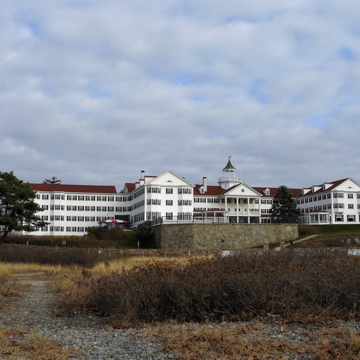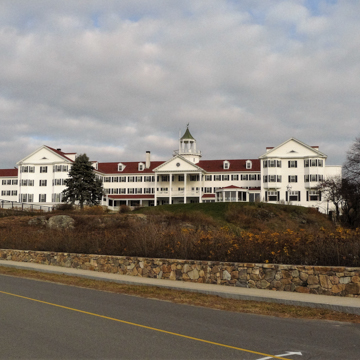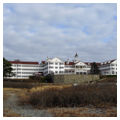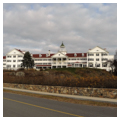You are here
Colony Hotel
Formerly Breakwater Court, the iconic Colony Hotel facing the sea remains one of Maine’s few pre-World War I summer hotels. Built in 1913–1914, the sprawling, white clapboard hotel with its green shutters and distinctive red roof retains its historic integrity and continues to function as a quintessential New England summer hotel.
A nautical landmark, the grand Colonial Revival hotel is located at the mouth of the Kennebunk River in Kennebunkport, and the Cape Arundel headlands. Kennebunkport, like so many Maine seaside towns, flourished in pre-Civil War America as a shipbuilding center. When shipbuilding faded after the war, the town’s stunning scenic location and rail accessibility attracted tourists. In 1913 on the site of the former Ocean Bluffs Hotel, which had been destroyed by fire in 1898, hotelier Reuel W. Norton built a new hotel called the Breakwater Court.
Norton commissioned Boston architect Henry Payson Clark to design the hotel. With his partner John Russell, Clark had already designed buildings all along Cape Arundel, but this commission was the firm’s largest. The white, clapboard-sided, three-story, Colonial Revival hotel is U-shaped, with a central pediment, two-story portico, and a cupola. The cupola features a large weathervane of a ship under full sail. A wide, wraparound porch spans the 300-foot, oceanfront facade of the main building and continues across two wings that end in octagonal pavilions. The east facade has a two-story pedimented portico and porte cochere. In 1917 Norton added a northern wing to the otherwise symmetrical building.
A grand lobby with a large fireplace occupies much of the hotel’s commodious first floor. At the north end are public reception rooms, a parlor, a ballroom, and library. Norton operated the Breakwater Court until his death in 1922, at which time his son took over the hotel. In 1947 the younger Norton sold the hotel to George Boughton, who owned the grand Colony Hotel in Delray Beach, Florida, and was the son of Atlantic City hotelier Charles Boughton. Boughton renamed the hotel the Colony as a New England sister to his Florida resort.
In addition to the central building, the hotel also consists of a brick carriage house, four staff dormitories, and two additional buildings: the Galland House, a former private residence, and the East House. The latter is a two-story building remodeled from the 1903 Oceanic Hotel, which, in turn, had been remodeled from the remains of the former Glen House (1880). The Colony acquired the Oceanic in 1954, and in 1965 John Calvin Stevens II transformed the hotel into several appendages, including the East House, the Florence House (adjacent to the main building), and the Boughton House. Today, in addition to its ballroom and library, the oceanfront Colony has 125 guest rooms, a saltwater swimming pool, business center, and a restaurant.
References
Butler, Joyce. The Kennebunks: A Watering Place. Kennebunk, ME: Brick Store Museum, 1983.
Lovejoy, Kim, and Kevin Murphy. Colonial Revival Maine. Princeton: Princeton Architectural Press, 2004.
Tolles, Bryant F. Jr. Summers by the Seaside: The Architecture of New England Coastal Resort Hotels, 1820–1950. University Press of New England, 2008.
Writing Credits
If SAH Archipedia has been useful to you, please consider supporting it.
SAH Archipedia tells the story of the United States through its buildings, landscapes, and cities. This freely available resource empowers the public with authoritative knowledge that deepens their understanding and appreciation of the built environment. But the Society of Architectural Historians, which created SAH Archipedia with University of Virginia Press, needs your support to maintain the high-caliber research, writing, photography, cartography, editing, design, and programming that make SAH Archipedia a trusted online resource available to all who value the history of place, heritage tourism, and learning.

















